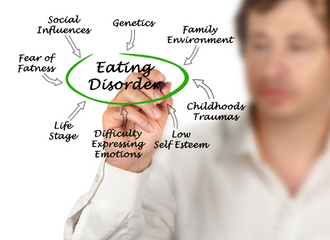Written By: Kristen Raspanti, MOT
Clinical Program Manager at The Renfrew Center of Philadelphia-Spring Lane
Exercise can be a healthy lifestyle choice and is often recommended to improve overall health and wellness. However, exercise can be difficult for someone with an eating disorder. Sports, exercise, or physical activity can be beneficial in moderation – with appropriate intention, nutritional intake, and rest.
Why Do We Exercise?
 It is important to identify the intention behind the exercise – Why does someone want to engage in a specific activity? Is it for enjoyment or to change the shape or size of the body in some way? Or is it because of the feelings/emotions they feel after the exercise? Emotion Driven Behaviors (EDBs) are behaviors that are driven by an emotion. Some emotionally driven behaviors provide short term emotional relief but are not beneficial long term. Strong emotions can tell us or “drive” us to engage in specific behaviors sometimes before we even have a chance to think about it. Exercise can be a common emotion driven behavior when someone is feeling an emotion and turns to exercise to provide that relief. This then leads to increased exercise behaviors due to the behavior being negatively reinforced.
It is important to identify the intention behind the exercise – Why does someone want to engage in a specific activity? Is it for enjoyment or to change the shape or size of the body in some way? Or is it because of the feelings/emotions they feel after the exercise? Emotion Driven Behaviors (EDBs) are behaviors that are driven by an emotion. Some emotionally driven behaviors provide short term emotional relief but are not beneficial long term. Strong emotions can tell us or “drive” us to engage in specific behaviors sometimes before we even have a chance to think about it. Exercise can be a common emotion driven behavior when someone is feeling an emotion and turns to exercise to provide that relief. This then leads to increased exercise behaviors due to the behavior being negatively reinforced.
What Is Overexercise?
1 Overexercise, also known as excessive exercise, is not recognized as a clinical diagnosis in the DSM-5. 2 Researchers have defined it as exercising to the extent of losing control and feeling a compulsive need to continue doing it even when these behaviors impair functioning and/or cause physical injury.
Overexercise & Eating Disorders
Typically, when someone is physically active, their body responds with increased hunger cues. However, for someone with an eating disorder, the body does not always respond appropriately. Restriction and increased movement can result in malnutrition. This will then lead to many additional physical and psychological side effects.
Side Effects
3 There are many medical and psychological consequences of overexercise. Too much of anything can have a harmful impact. Some of the physical side effects can include:
- Dehydration
- Fatigue
- Amenorrhea
- Skeletal injuries
- Heart conditions
- Tissue damage, bruising and joint pain
- Nutrient deficiencies and metabolic changes
- Altered resting heart rate
- Increased in frequency of illness
- Bone density loss (osteopenia or osteoporosis).
The psychological side effects can include:
- Increased anxiety/guilt if unable to exercise
- Mood swings
- Depression
- Interferences with relationships/responsibilities
- Viewing exercise as a “have to” instead of a “want to”
Warning Signs
Many people with eating disorders struggle to have a healthy relationship with exercise. For some, it can be a form of purging and is considered a symptom of their eating disorder diagnosis. In a culture obsessed with health and fitness, the signs of over-exercise can be easily minimized or dismissed entirely. Over-exercise can also be tricky to spot in athletes, as training and conditioning programs can often be intense and demanding. It’s important to know the warning signs of over-exercise because you or a loved one may actually be experiencing the symptoms of a clinical eating disorder.
4 Warning signs of overexercise behaviors include the following:
- Perfectionism with a routine
- Control/rules around exercise
- Compulsive behaviors with a rigid regimen (despite weather, fatigue, illness, or injury)
- Feelings of inadequacy (feeling as though you are not good enough, fast enough or not pushing hard enough during a period of exercise)
- Difficulty having fun
- Athletes training much longer, much more frequently, and much more intensely than what is typically recommended for the sport
- Conflict/problems with relationships (withdrawal from family and friends)
- Exercise that significantly interferes with important activities, occurs at inappropriate times or in inappropriate settings, or when the individual continues to exercise despite injury or other medical complications, intense anxiety, depression, irritability, feelings of guilt, and/or distress if unable to exercise, discomfort with rest or inactivity, exercise used to manage emotions.
Additional warning signs include using exercise to “earn” or “burn” food and exercising in secret. Exercise can be a difficult challenge for those in recovery. Whether it is a newly acquired behavior or a previously existing symptom of the eating disorder, many people often wonder if they will be able to engage in movement both mindfully and joyfully during the recovery process. If you notice rigid beliefs, distressing emotions, and intense urges associated with exercise, the deeper work might include processing your emotions, prioritizing rest, building distress tolerance, and working with your treatment team to improve your relationship with movement. Tracking exercise or any type of movement with logs, apps, or devices may also be something worth exploring with your team to identify whether these things are actually helping or hindering your recovery.
[For more, check out our Podcast Episode, How Much is Too Much? Understanding and Treating Over-Exercise in Eating Disorder Recovery]
Treatment Approaches
A multidisciplinary team with expertise in the treatment of eating disorders and exercise can provide support, structure, and guidance as you develop a healthier relationship with movement. Given the serious physical and psychological consequences that can result from eating disorders and overexercise, it is critical to seek professional support as soon as possible. Medical stability needs to be the priority and may require rest for the body physically and emotionally in the beginning. When this is achieved, movement could be incorporated slowly with the focus on the intention.
In our residential setting, residents reflect and process their relationships with exercise through individual and group therapy. A wide variety of groups are specifically designed to help patients mindfully re-connect with their bodies by engaging in different forms of movement. Residents aim to regain the enjoyment of movement again in a balanced and appropriate way. Also, as discharge from residential program approaches, residents can also explore what they would like their relationship to look like in recovery during an individualized exercise consultation. With the support of an experienced treatment provider, these consultations are a safe space to create a structured relapse prevention plan to help manage urges to over-exercise in the home environment.
Conclusion
Over-exercise can be a debilitating symptom of a clinical eating disorder and managing the intrusive thoughts, distressing emotions, and intense urges associated with it can be very difficult to do without professional support. If you are concerned about you or a loved one’s relationship with exercise, please speak with a treatment professional, if possible. Eating disorders are serious and complex psychiatric conditions that can have severe physical, psychological, and social consequences over time. Everyone deserves supportive, compassionate, and quality care from experienced treatment providers to develop a healthier relationship with food, body, and exercise. Recovery is possible! For more information on The Renfrew Center’s treatment program, you can call 1-800-Renfrew or visit us online at www.renfrewcenter.com.
References:
[1] American Psychiatric Association. (2022). Diagnostic and statistical manual of mental disorders: DSM-5-TR. American Psychiatric Association Publishing. https://doi.org/10.1176/appi.books.9780890425787 [2] Trott, M., Jackson, S. E., Firth, J., Jacob, L., Grabovac, I., Mistry, A., Stubbs, B., & Smith, L. (2021). A comparative meta-analysis of the prevalence of exercise addiction in adults with and without indicated eating disorders. Eating and weight disorders: EWD, 26(1), 37–46. https://doi.org/10.1007/s40519-019-00842-1 [3] Weinstein, A., & Szabo, A. (2023). Exercise addiction: A narrative overview of research issues. Dialogues in clinical neuroscience, 25(1), 1–13. https://doi.org/10.1080/19585969.2023.2164841 [4] Alcaraz-Ibáñez, M., Paterna, A., Sicilia, Á., & Griffiths, M. D. (2020). Morbid exercise behaviour and eating disorders: A meta-analysis. Journal of behavioral addictions, 9(2), 206–224. https://doi.org/10.1556/2006.2020.00027


